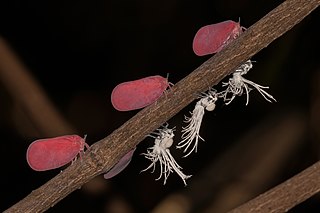
The family Fulgoridae is a large group of hemipteran insects, especially abundant and diverse in the tropics, containing over 125 genera worldwide. They are mostly of moderate to large size, many with a superficial resemblance to Lepidoptera due to their brilliant and varied coloration. Various genera and species are sometimes referred to as lanternflies or lanthorn flies, though they do not emit light.

Delphacidae is a family of planthoppers containing about 2000 species, distributed worldwide. Delphacids are separated from other "hoppers" by the prominent spur on the tibia of the hindleg.

Pyrops is a genus of planthoppers that occur primarily in southeast Asia, containing about 70 species. They are fairly large insects, with much of the length due to an elongated, upcurving, snout-like projection of the head. The wings are generally brightly patterned in contrasting colors, and they are popular among collectors.

The subfamily Aphaeninae is a group of hemipteran insects, especially abundant and diverse in the tropics. They belong to the Fulgoridae (fulgorids), though they are not among the better-known members of that family that are called "lantern bugs" or "lanternflies". In 2009, the first molecular analysis of the Fulgoridae challenged the existing structure of eight currently recognized subfamilies and eleven tribes.

Flatidae are a family of fulgoroid planthoppers. They are cosmopolitan in distribution and are distinguished from others in the superfamily by a combination of characters. Like all other planthoppers, they suck phloem sap of plants. Some species are known to communicate with vibrations through the plant stems. Communication may be with mates, or with ants that tend the nymphs, protecting them and gathering honeydew secretions. Adults of some species have brightly coloured forewings which are tougher and known as tegmina unlike the membranous hindwings which are used for flight. Although a few can be identified by their coloration, most species requires dissection and examination under a microscope with access to literature on already described species.

Issidae is a family of planthoppers described by Spinola in 1839, belonging to the order Hemiptera, suborder Auchenorrhyncha superfamily Fulgoroidea.
Oecleini is planthopper tribe in the subfamily Cixiinae.

Lophopidae is a family of fulgoroid plant-hoppers with most species found in tropical South America and Asia. Most members of the family are characterized by the face being longer than wide with at least two lateral ridges. The hind tibia can bear some spines, two to three. Lateral ocelli are present below the compound eye and slightly in front of it. The wings are broad and held somewhat flat and the wings are often patterned. The nymphs have two long tails and many members have slightly flattened front tibiae.

Penthicodes is a genus of bugs (Auchenorrhyncha) belonging to the family Fulgoridae, subfamily Aphaeninae: found in South-East Asia.
Aloha is a genus of planthopper named by George Willis Kirkaldy in 1904. As of 2018, ten species are recognized:

Tropiduchinae is a subfamily of tropiduchid planthoppers in the family Tropiduchidae.

The subfamily Poiocerinae include Hemipteran insects in the family Fulgoridae, found especially in the tropics.

Acanaloniidae is a family of planthoppers. It is sometimes treated as a subfamily of Issidae.

Nilaparvata is a genus of bugs in the subfamily Delphacinae and tribe Delphacini Leach, 1815.

The Tettigometridae are a family of Fulgoromorpha (planthoppers), with a species distribution from: Europe, Africa, Asia through to west Malesia.
The Achilixiidae are a family of Fulgoromorpha (planthoppers); species may be found in the neotropical and Asian regions.

Hemisphaerius is a genus of bugs in the family Issidae and tribe Hemisphaeriini. Species resemble the closely related Gergithus: but are differentiated in this genus by the size of the frons and shorter legs.

The Hemisphaeriinae are a subfamily of bugs in the family Issidae, based on the type genus Hemisphaerius. Species in 107 genera have been recorded in most continents, but the greatest diversity appears to be in South-East Asia.












